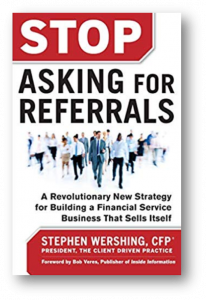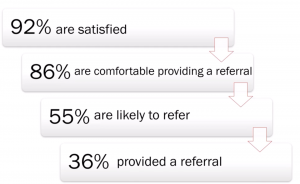
How to Get 401k Referrals the Right Way
In this article, I want to share with you some referral marketing strategies I’ve learned over the years, as well as some tips courtesy of Stephen Wershing, CFP® and his book, Stop Asking for Referrals (with permission).
I’d highly recommend that you pick up and read a copy of this his book because it is, by far, the most comprehensive book on referral marketing that I’ve personally ever read.
 You’ve Been Doing it All Wrong
You’ve Been Doing it All Wrong
Stephen says to forget all of the bad advice you’ve ever heard about asking your clients to give you names….advice that tells you to say things like:
“Who do you know that can use the kinds of services I have provided you?”
“The most important way I get new clients is referrals from existing clients.”
“Can you think of three people who could use the kinds of solutions we’ve provided as I’d like you to write down their names and phone numbers?”
Or have you used this one before; “I get paid three ways…”
Or how about…”Can we agree that if I do a good job, you will recommend me to other people you know?”
These are all ways we’ve been taught to ask for referrals and they’re all wrong.
You don’t want to ASK for referrals, you want to ATTRACT referrals.
There are several reasons why asking is not an effective strategy. First of all, most of us feel very uncomfortable asking… but more importantly, it’s uncomfortable for your client. It puts them on the spot, it makes the assumption that your services are so extraordinary that they’d want to tell others about you, and it calls into play the level of trust they have with you and your ability to not embarrass them or tarnish their good name.
In Stephen Wershing’s book, he writes about the problems created by constantly asking your clients for referrals: He says,
- First: it places an uncomfortable demand on your clients. You provide a service and for that, they compensate you. Asking your clients to serve you gets the relationship backwards and in turn violates client expectations.
- Next: it converts referrals into transactions. “If we do this, we would like you to do that.” This reduces it to an economic transaction and cheapens it.
- Third: it distorts the message you want to communicate. Don’t say, “If you help me find new clients, I can spend less time marketing and more time providing service to you.” When you do this it makes your client think, “I’m not paying you enough? So you’re spending all your time marketing and not taking care of me?”
- And finally, Stephen says it puts the focus on YOU. In a well-designed referral system, the focus should remain on the client. Clients provide referrals because they derive benefits from introducing their friends and acquaintances, not because it’s an obligation. Once the activity changes to providing you benefits, you have just short-circuited much of the motivation for providing them to you.
Let’s Look at Some Examples
 Here’s a great example from Stephen’s book:
Here’s a great example from Stephen’s book:
Say you go into a restaurant, have a fabulous time, a wonderful meal and the next day you run into a friend who says, “I’d like to take my wife out to dinner tonight and we’d like to try someplace new. Is there any place you’d recommend?”
What will you say? Well of course, you’ll tell him the story about what a wonderful time you had at the restaurant last night, and that he should give it a try.
In telling him that, you’d feel good – you’re helping your friend have a good time – giving him something of value – showing him that you’re knowledgeable in a small way in an area that’s meaningful to him.
But now let’s replay this scenario in a format more like what many advisors do…
You go to a restaurant, have a fabulous time, a wonderful meal, and with the check the waiter brings a piece of paper and a pen and says, “Along with you paying the bill, I would like to get the names of 3-5 of your friends who dine out periodically and their phone numbers.”
How would you feel about that?
If you’re like most, you’d feel a bit strange, you’d be uncomfortable.
Why? Because that process was all about the needs of the restaurant and not about the benefits you can get from recommending the restaurant to your friends. It violates the social contract you have with the restaurant and reflects the fundamental misunderstanding of why people refer their friends in the first place.
The truth about referral marketing is this – prospects buy when they are ready. Referrals is an event-driven business – when we ask for referrals, we won’t meet the prospects when they need us. Clients typically seek out an advisor because something has happened or changed. A situation arises, an event or attitude shift.
Good referrals then are defined partly by being introduced at the right time for the prospect.
Think about it, the probability that when you ask your client for a referral will turn out to be perfect timing for the prospect is miniscule. Odds are that if you ask for referrals, you will be calling those prospects at a time when they are just not receptive to your message. Like a great carpenter who shows up unannounced and unexpected on someone’s doorstep – if that happened to you, would you hire the carpenter?
Timing is Everything
In a study by Julie Littlechild called, The Anatomy of the Referral, she surveyed clients of financial advisors about many things from engagement to activity to referrals and one highlight in the survey indicated this:
There is no clear correlation between asking clients for referrals the way it’s traditionally done, and being referred.
In her survey of more than 1000 clients she asked the question, “What were the circumstances of the last referral you gave to your advisor?” and the results showed:
- 48% said a friend specifically asked for a recommendation
- 57%, a little over half, said a friend described a challenge or need for which the person knew the financial advisor had a solution
- and just 2% – which is statistically equivalent to 0 – indicated they gave the referral because an advisor asked for a name
So in almost all cases, people gave referrals because their friends or acquaintances expressed a need, and they wanted to help.
A great line that Stephen uses is this…
“A referral is not something a client gives you; a referral is something he/she gives a friend.”
Think about that.
In order for this to happen, your clients need to feel comfortable enough with you and your services to feel like they’re benefiting their friend and their relationship with their friend in doing so.
Think about how often you give your friends referrals.
You probably do it more than you realize. Just yesterday I told an advisor looking for a service that provides gap reports to contact Ed Dressel at RetireReady because the owner of that firm has created a fantastic service, their reports are customizable and designed to move the needle, and the customer service is first rate.
I posted pictures of the dinner I had on the top of Mount Washington on twitter because the food and presentation were AMAZING and the view is voted one of the best city views in the entire U.S. for a reason.
We give referrals all the time to our friends and neighbors and colleagues when we recognize a solution that matches the problem or question.
So, When is the Right Time?
The key to getting clients to give more referrals is to help them recognize when it would be appropriate to refer you.
 In the Julie Littlechild study, 92% of clients said they were comfortable providing a referral to their financial advisor, yet only 36% had ever actually made a referral.
In the Julie Littlechild study, 92% of clients said they were comfortable providing a referral to their financial advisor, yet only 36% had ever actually made a referral.
Attracting referrals becomes a matter of training clients to remember to mention you at the right time – it’s about helping people to remember you when THEY can benefit from mentioning you.
People don’t say – who can I call to tell about this great carpenter I know – that’s not how it works, they need to be trained to identify the opportunities where you could help them and to give your name when the opportunity presents itself.
Referral Marketing Strategy – Be Valuable
One of the first ways to make referral marketing more effective is to be valuable.
You have to be worth talking about…Seth Godin says…
”If the marketplace isn’t talking about you, there’s a reason – the reason is that you’re boring.”

Do you deliver an experience that people WANT to pass along?
What does great customer service look like?
Delivering superior customer service alone is not enough to attract consistent referrals, it is a prerequisite.
Customers don’t want to refer someone that does an adequate job. They want to refer someone that does a great job, someone that has a proactive service model, keeps them informed, simplifies the complicated stuff, manages the time-consuming stuff, and follows up on the administrative stuff. Superior client experiences is a good starting point.
Understand What Your Clients Find Valuable
A better starting part is to identify what your clients find valuable, and measure and monitor what good customer service means from those that pay you to deliver.
In Julie Littlechild’s studies, she identified that only those that were actively “engaged” by their advisors gave referrals. How can you engage your clients?
You can start by polling them. Don’t assume they’re satisfied with your services and that they value you as much as you value you.
Conducting client survey to confirm that you are delivering the kind of experience your clients want to share with other people. You can do this by making a discussion of client expectations a standard part of your service process so you can ensure you meet or exceed them.
At your annual review meeting, after reviewing the services you’ve provided over the last year, find out which services they found to be the most valuable, the least valuable, and what would they like to see more of? You can ask questions like:
- Why did clients first choose to engage you?
- Why do they continue to retain you?
- What would cause them to leave?
- What do they value most about what you do for them?
What matters is that you exceed the client’s expectations – not your expectations of what the client wants. And all clients are different. Identify where your clients truly see your value to be. Use the comments and feedback received to constantly refine and monitor your services and your customer’s perceived value of those services.
Get Clear on Your Competitive Advantage
It’s not enough just to give your clients a business card and then call it a strategy.
Getting your clients to the point that they mention you is the first step.
The next step is to work with them on how to describe what you do in a way that the prospect immediately sees an easily defined value to having a conversation with you.
This is what I call finding your competitive advantage. In the book, How to Get Your Competition Fired by Randy Schwantz, he describes the three ways you can have a competitive advantage.
- First, you can provide a service that is unique, that no one else provides.
- Second, you can provide a service that others provide, but you have a better process for it that gets better results.
- Or third, you can describe the service you offer in such a clear and compelling way that prospects are motivated to buy from you rather than from your competition.
Define Your Niche
Next, you need to define your niche.
For people to refer you consistently, you must represent a clear solution for a type of problem or type of client.
This is not possible if you have a defined client as “companies that offer 401k plans.”
Think about it, specialists make more than generalists and get more referrals – but it’s a difficult concept for advisors to embrace because no one wants to leave money on the table by casting a narrow net – so we become just like everyone else, in hopes to attract everyone else, and then we must compete with everyone else.
When you appeal to everyone – you appeal to no one. Niches equal riches.
Define your segment or target market that addresses some characteristic or challenge that a small portion of the population can relate to.
Your clients need to know what your competitive advantage is and be able to explain it so their friends understand it. This will never happen if you are not clear on this point yourself. You must define your target market, define your competitive advantage, and ensure it is consistently told in all of your marketing material, which brings us to the last point.
Your Story Must Be Compelling – and Consistent
In order to make referral marketing effective, you must have a consistent, professional, compelling story.
Your brochures, your website, everything you create should carry the same messages including your elevator speech. What is your differentiating factor? Describe it in a way that succinctly describes who you serve and how you help them – not the process by which you do it, but the benefits that demographic receives.
Take some time to talk with your clients about your ideal clients and discuss this in terms that help them identify when they should recall you as a referral source.
Create scenarios to repeat in your meetings as you address certain topics with them. Stephen’s book gives specific examples of scenarios that your customers might relate to if you want more guidance in this area. Reiterate who your ideal client is and how you can help them so when your clients encounter these situations, they instinctively know that referring you would help their friends.
If your client were to refer you to a friend, and gave them your name, firm name, and maybe even a website address or phone number, chances are, you’re going to be looked up online. With today’s technology, the internet is your background check, directions to your location, the yellow pages to find your phone number and when they find you, your website must reflect your competitive advantage.
Let’s start with just your website…
If someone were to find your website, would it show that you specialize in helping medical practices manage the complexities of offering self-directed accounts? Would it say your practice is focused on retirement benefits for employees of companies that have multiple locations and that you spend 26 weeks a year meeting one-on-one with participants? Does your website reflect the story your clients will tell? Do you want to get referrals from 401k clients and key referral centers but your entire website (minus one line of text buried in the corporate services section of your site) is all devoted to wealth management?
Start by defining your story, then ensuring your story is consistently applied throughout all the areas where you might be found on the internet.
LinkedIn is the second place, aside from your company website, where you need to have compelling reasons for people to contact you. Many use LinkedIn as simply a business card. Too many business cards though don’t tell people how you can help them, what’s the benefit of working with you, or offer any call to action. They’re what we call throw-aways or click-to-close if we’re talking about your online profile.
It’s important that you use your website and your LinkedIn profile to add value.
So ask yourself this question:
“Does my overall online presence REASSURE and REINFORCE the referrals I earn? Does it contain the most current, credible, and relevant marketing messages, positioning, content, resources, and value that will make my advocates LOOK BETTER – not worse – for referring me?”
(A great quote by David Newman.)
Center of Influence Referral Marketing Strategies…
On a final note, if the referrals you seek are aligned with center of influence marketing, there are different strategies you can employ to make this much, much more effective.
- First is the concept of reciprocity. Forget about it. Don’t expect to get referrals and stop providing value just because you don’t see immediate business come your way. Centers of Influence have a different set of reasons for giving referrals than your existing clients. Centers of Influence are first and foremost concerned with how well their clients will be taken care of and unless you’ve proven to them through your education, value and relationship that they can trust you to serve their clients to the highest standard, you will not earn referrals. You have to make a deposit into the relationship before you can expect to start seeing anything come your way.
- Also, it’s important that you know what kind of client would be an ideal client for them, and you must be very clear and able to help them identify who your ideal client is. Remember, if you’re too general trying to help everyone, your name and your service offering won’t automatically come to mind as a reference like it would if you’re able to tell the COI that you work with start-up plans in the manufacturing industry, or you work with doctor groups in the Pittsburgh area.
- You must demonstrate value. Find out how you can help your CPA, TPA, or ERISA attorney. Provide your support and assistance first. Offer them education or information or checklists that they can pass on to their clients that make them look good. Consider joint initiatives like providing a calendar of important reporting deadlines and get permission to co-brand it then you can both hand it out to your clients. This gets the COI’s name in front of your clients and your name in front of their clients and builds value and credibility. Host a joint education seminar that’s not a sales pitch but a value-added teaching program.
It’s essential to be a valuable resource to the centers of influence from which you hope to earn referrals long before you should ever expect any.
Next up, we’ll talk about Content Marketing…
Effective 401k Prospecting Strategies
This article is part of a series covering effective 401k Prospecting Strategies. You can access the full series using the links below:
- Part 1 – 401k Prospecting Strategies – Push vs. Pull
- Part 2 – How to Get Referrals the Right Way (this article)
- Part 3 – How to Use Content Marketing to Grow Your 401k Plan Practice
- Part 4 – Cold Calling 101 – Tips for Success
- Part 5 – How to Build a 401k Prospect Pipeline Process
- Part 6 – What I Learned from Jane Murphy That Can Help You Close More 401k Plan Business
- Part 7 – Education-Based Marketing – An Effective 401k Business Growth Strategy
- Part 8 – The 5 Success Principles for Closing More Business and Creating Raving Fans
Listen to the Podcast episode of this topic here (coming soon).
Or watch the video on YouTube here (coming soon).
Credits:
Restaurant Photo: Photo by Zane Persaud on Unsplash
Statistics Image: The Anatomy of a Referral
Affiliate Disclaimer: As an Amazon Affiliate, if you make a qualifying purchase on Amazon, I may receive a commission (at no extra cost to you). I only recommend books I’ve read and feel you can benefit from.